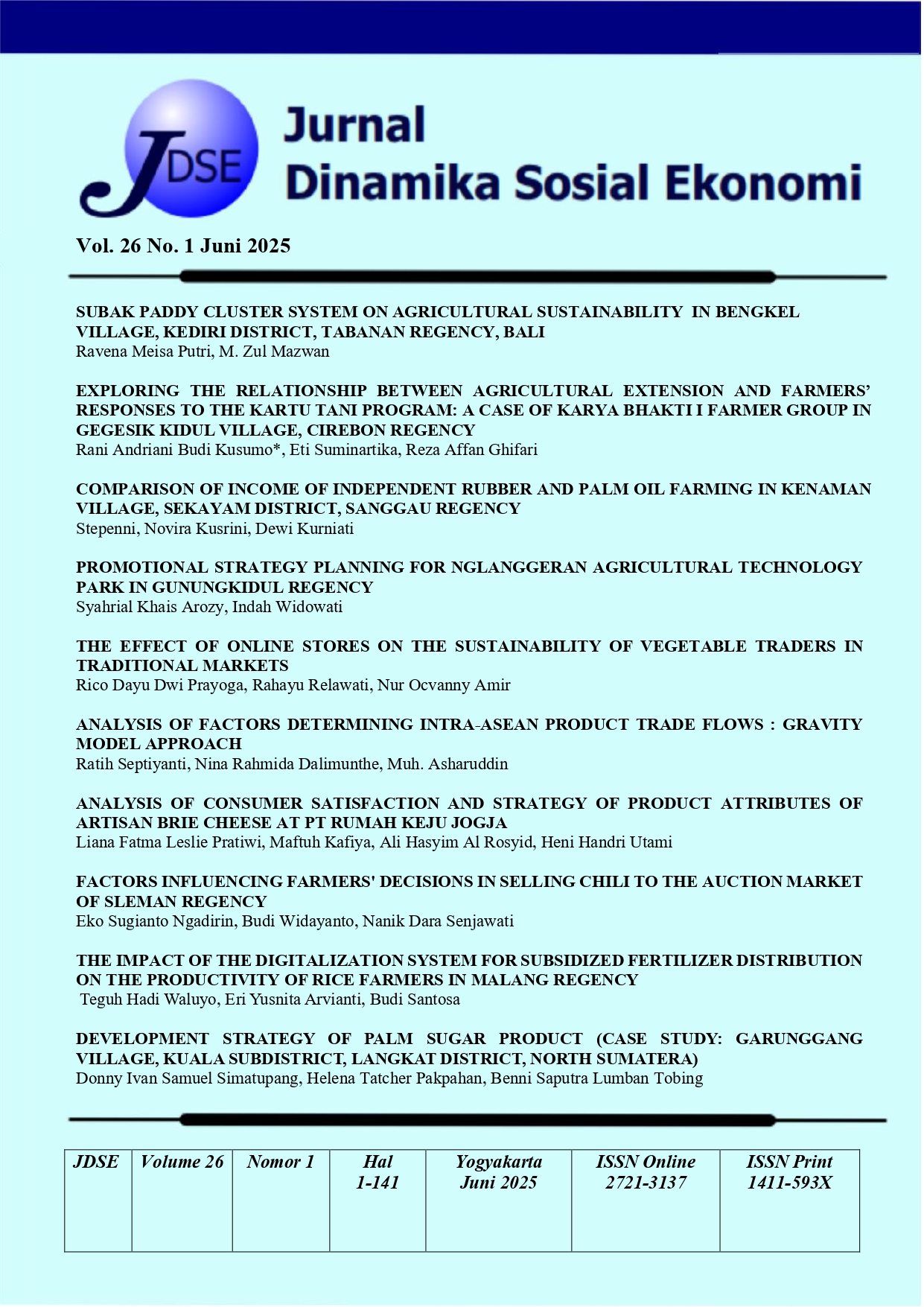Analysis of Factors Determining Intra-ASEAN Product Trade Flows : Gravity Model Approach
DOI:
https://doi.org/10.31315/jdse.v26i1.14773Keywords:
regional trade, Model Gravity, ASEANAbstract
International trade encourages the creation of economic cooperation regionally. Integration of the ASEAN Economic Region by initiating the ASEAN Free Trade Area (AFTA) is expected to increase intra-ASEAN trade. However, the contribution of trade between ASEAN countries to ASEAN trade value has experienced stagnant growth and is still dominated by trade between countries outside the ASEAN region. The aim of this research is to determine the factors that influence trade flows between ASEAN countries so that they can encourage the value of trade between ASEAN countries. The data used in this research is panel data consisting of 10 ASEAN member countries for 17 years which is explained using a gravity model approach. The research results show that the GDP variables of exporting countries, population of export destination countries and trade openness have a significant positive influence on the value of trade between ASEAN countries. ASEAN countries need to consider a country's trade openness when formulating international trade policies in order to have a positive impact on increasing trade value.
References
[CEPII] Centre d’Etudes Prospectives et d’Informations Internationales. Geodesic Distances. http://www.cepii.fr/distance/dist_cepii.zp [15 Maret 2024]
[FTA Center] FTA Center Kementerian Perdagangan. 2023. Free Trade Agreement.https://ftacenter.kemendag.go.id/free-trade-agreement [1 April 2024].
[ASEAN] ASEAN Statistical Yearbook. 2023. https://www.ASEANstats.org/wp-content/uploads/2023/12/ASYB-2023-v1.pdf [25 Maret 2024]
ASEANstats. (2025). ASEAN in figures. ASEAN Statistics Division. Retrieved June 26, 2025, from https://www.ASEANstats.org/ASEAN-in-figures/
Asharuddin, M., Rifin, A., & Nurmalina, R. (2024). Faktor-Faktor yang Memengaruhi Aliran Perdagangan Produk Antarnegara ECOSOC 2023. Jurnal Dinamika Sosial Ekonomi, 25(1), 121-133. https://doi.org/10.31315/jdse.v25i1.12312
Astuti, E. P., Nurmalina, R., & Rifin, A. (2023). Pengaruh Hambatan Tarif Dan Sps Pada Perdagangan Pertanian Indonesia Dengan Negara G-20. Buletin Ilmiah Litbang Perdagangan, 17(1).https://doi.org/10.55981/bilp.2023.12
Chakrabarti, A. S.(2018). Dispersion In Macroeconomic Volatility Between The Core And Periphery Of The International Trade Network. Journal of Economic Dynamics & Control, https://doi.org/10.1016/j.jedc.2018.01.019.
Cuyvers, L. (2025). The impact of the ASEAN Free Trade Agreement on intra-ASEAN trade: a review of empirical literature. United Nations.
Fujii, E. (2019). What does trade openness measure?. Oxford Bulletin of Economics and Statistics, 81(4), 868-888. https://doi.org/10.1111/obes.12275
Jayathilaka, R., Jayawardhana, C., Embogama, N., Jayasooriya, S., Karunarathna, N., Gamage, T., & Kuruppu, N. (2022). Gross domestic product and logistics performance index drive the world trade: A study based on all continents. PloS one, 17(3), e0264474.
Krugman, P. R., & Obstfeld, M. (2009). International economics: Theory and policy. Pearson Education.
Miller, T., Kim, A. B., Roberts, J. M. andTyrrell, P. (2019). Highlight of The 2019 Index of Economic Freedom. Washington, DC: The Heritage Foundation.
Nam, H. J., & Ryu, D. (2024). Does trade openness promote economic growth in developing countries?. Journal of International Financial Markets, Institutions and Money, 93, 101985. https://doi.org/10.1016/j.intfin.2024.101985
Pohan, F., Rifin, A., & Nurmalina, R. (2024). Faktor-Faktor Yang Memengaruhi Aliran Perdagangan Produk Pertanian Antar Negara ASEAN. In Forum Agribisnis: Agribusiness Forum (Vol. 14, No. 1, pp. 1-7). https://doi.org/10.29244/fagb.14.1.1-7
Pertiwi, R. S., Herianingrum, S., Al Mustofa, M. U., & Muhammad, M. (2019). Studi empiris government effectiveness dan trade openness terhadap perdagangan internasional. Jurnal Ekonomi, 24(3), 350-367.
Sihombing, P. R., ST, S., Stat, M., & PS, C. (2021). Analisis Regresi Data Panel. STATISTIK MULTIVARIAT DALAM RISET.
Suryanto, S., & Kurniati, P. S. (2022). Analisis Perdagangan Internasional Indonesia dan Faktor-Faktor yang Memengaruhinya. Intermestic: Journal of International Studies, 7(1), 104-122
Syachbudy, Q. Q., Firdaus, M., & Daryanto, H. K. S. (2017). Analisis Faktor-Faktor Ekspor Produk Pertanian Indonesia ke Negara Kurang Berkembang. Jurnal Agribisnis Indonesia (Journal of Indonesian Agribusiness), 5(1), 57-74. https://doi.org/10.29244/jai.2017.5.1.57-74
TheGlobalEconomy. 2024. Trade Openness-country rankings. https://www.theglobaleconomy.com/rankings/trade_openness/ [15 Maret 2024].
UN COMTRADE. 2024. United Nations Comodity Trade Statistics Database. https://comtradeplus.un.org/[15 Maret 2024].
Van Bergeijk, P. A., & Brakman, S. (Eds.). (2010). The gravity model in international trade: Advances and applications.
Wijayanti, I. K. E., & Rachmanto, A. (2023). Daya Saing dan Faktor-Faktor yang Mempengaruhi Ekspor Cengkeh Indonesia. Jurnal Dinamika Sosial Ekonomi, 24(2), 126-140. https://doi.org/10.31315/jdse.v24i2.10021
Worldbank. 2024. World Development Indicator.http://www.data.worldbank.org [15 Maret 2024].
Yuliansyah, E., Suprihanti, A., & Puspitaningrum, D. A. (2023). Analisis keunggulan komparatif dan kompetitif ekspor cengkeh antara Indonesia dan Madagaskar di pasar dunia. Jurnal Dinamika Sosial Ekonomi, 24(1), 98-111.
Downloads
Published
How to Cite
Issue
Section
License
Copyright (c) 2025 Ratih Septiyanti, Nina Rahmida Dalimunthe, Muh. Asharuddin

This work is licensed under a Creative Commons Attribution 4.0 International License.











_(3).png)
